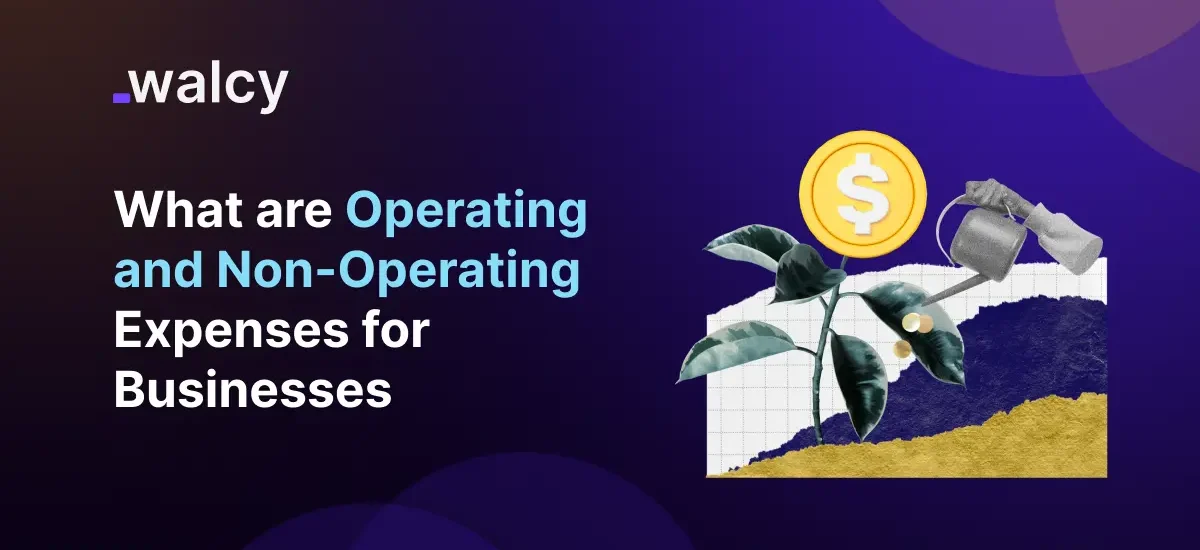Understanding the distinction between running and non-operating expenditures is critical to good business management. These two types of costs constitute the cornerstone of a company’s financial statements, thus they are very important for profitability and general economic health. Business owners and managers who thoroughly grasp operating and non-operating expenses will make better judgments that benefit their bottom line.
The definitions, examples, and significance of both operational and non-operating expenditures will be discussed. We will also discuss how these costs affect financial reporting and propose a solution to handle them effectively.
What are Operating Expenses?
Operating expenses are sometimes referred to rather informally as “opex” which are the costs a business must pay as a result of normal operations. These are expenses arising during the everyday operation of the business and are indirectly associated with revenue generation. Good management of the operating expenses is important since they impact a firm’s efficiency in operation and profitability directly.
Definition of Operating Expenses
Operating costs refer to expenses incurred to maintain the day-to-day operations of a business. Both fixed and variable costs are included in these categories. Fixed operating costs, such as rent and salaries, remain relatively constant irrespective of business activity. Variable operating costs include raw materials and utility expenses; these vary proportionately with production or sales volume.
Operating costs are possibly a company’s most critical cost structure. Typically, it is looked at in conjunction with a company’s gross profit, operating income, and net income. A business must manage its operating costs to the maximum possible to remain efficient in its operations.
Examples of Operating Expenses
Some of the major operating costs in modern businesses include:
Rent and Utilities: In most scenarios, rent refers to the payment made for the use of office space, warehouses, or any other type of property. It is usually a fixed monthly expense. On the other hand, utilities are expenses incurred for using essential services such as electricity, water, internet, and waste management. These costs vary according to the usage.
Salaries and Wages: These refer to the expenses paid to the employees for their work contribution to the organization. It can vary to the number of employees hired in the organization. Labor cost is one of the major contributors to the operating expense of a business.
Office Supplies: It refers to the expense of the office on the necessary stationery requirements, such as stationery, furniture, and other operational equipment.
Marketing and Advertising: Online and social media campaigns and traditional media advertisements contribute to spreading awareness in the marketplace of the company’s presence. These marketing costs support sales and hence growth in revenues.
Maintenance and Repairs: All costs that keep up or maintain equipment, plant machinery, and other facilities in good working order. Proper and timely servicing stops huge losses from the breakdown of a particular asset and extends its life.
Depreciation: Depreciation also comes under the operation expense. The value of fixed assets such as plant machinery, vehicles, and buildings depreciates over a period. It is the kind of accounting expense reflecting the wear and tear on tangible assets.
In order to manage salaries of employees working abroad, business need to choose the reliable payment provider. Walcy can be one option to choose.
Importance of Management of Operating Expenses
There are various reasons why the management of operating expenses is necessary. Number one, it helps companies maintain their bottom line by controlling expenditure items that are relevant and will directly help in maintaining profitability. The proper management of operating expenses will ensure the ability on the part of the company to reinvest in growth opportunities without affecting the stability of the company. Finally, operating expenses will help businesses guide decisions on prices to be offered, budgeting, and cost-cutting policies.
What are Non-Operating Expenses?
It refers to such expenses that are incurred as a result of activities that do not directly relate to the major revenue-generating activities of a business. Even if they may not occur as frequently as the company’s primary operations, they can nevertheless have a big impact on a corporation’s net income, therefore it’s important to thoroughly comprehend them to exercise more effective control.
How Non-Operating Expenses Affect Financial Reporting
Non-operating costs are typically reported as a line separate from operating expenses in the income statement. Then, stakeholders can differentiate instantly, between costs associated with the core operations and everything else. Separating non-operating costs allows companies to provide a clear view of their operational performance and profitability.
Examples of Non-Operating Expenses
Interest Expenses: Businesses need to pay Interest on borrowed money, including interest on loans, bonds, or other debt instruments. It is considered non-operating because it relates to the business’s financing activities rather than its core operations.
Loss on Sale of Assets: Losses suffered by an organization when selling an asset at a price below the book value of the asset. This can be because of a reduced market value, or it can potentially be because of an organization being under the liquidation pressure of assets at lower prices.
Lawsuit Settlements: The expenses of the cases settled in or decided against the interest of the firm. Such costs can be very vast and are almost entirely unpredictable, and hence uncontrollable.
Restructuring Costs: This is a one-time cost, and it is used in major organizational changes by a company, including layoffs and closing down some facilities or mergers. Restructuring expenses are typically one-time in nature but very material in their impact on the financials.
Currency Exchange Losses: This happens because of an exchange rate fluctuation for firms that operate in various nations. Very likely, the losses in currency exchange will impact a company in businesses involving foreign currency dealings or international operations.
Read about: Factors affecting foreign exchange rates
Non-Operating Income: A Counterbalancing of Non-Operating Expenses
As much as companies incur non-operating expenses, they can also gain non-operating income. Non-operating income is defined as any current inflow that is gained outside the core business activities. The income will be shown on the current income statement, but apart from operating revenue.
Examples of Non-Operating Income
The non-operating income may be obtained from various businesses; hence, it involves:
Interest Income: it refers to income earned on interest-bearing accounts, investments, or loans the company makes to other businesses. This is popular among businesses that have extra cash reserves or who invest in various financial instruments.
Gains on Sale of Assets: It is the income generated from selling an asset for more than its book value. This happens in a scenario where the market value of a previously acquired asset appreciates over time. For instance, if a business has invested in gold, its price might rise over time.
Dividend income received: The revenue from investments made in other firms, which in return pay dividends. This is for those businesses owning equity in other firms and thereby get an inflow of money regularly because of dividend incomes. from the normal operations of a business.
Operating vs. Non-Operating Expenses
The difference between operating and non-operating expenses can be quite meaningful; therefore, it is quite critical for financial analysis and accurate reporting. These are:
Frequency and Regularity: Operating expenses occur many times during the continuation of activities of the business. However, non-operating expenses are rare and usually occur only when there are peripheral activities.
Impact on Revenue: The direct relation of operating expenses with revenue generation means that they are related to the mainstream activities of the business. Non-operating expenses do not have a direct relation to the generation of revenue and mostly relate to incidental activities.
Financial Reporting: Operating expenses would be reported as part of the income statement, in the operating income section. Usually, non-operating expenses are shown below operating income, as it does not deal with the primary operations of the company.
Managing Operating Costs and Non-Operating Costs
Managing operating and non-operating costs effectively and efficiently is critical for adapting and preserving your financial position. Note down the strategies that business organizations can make use of:
Budgeting and Forecasting: Establish clear budgets for both operating and non-operating expenses. Regularly forecast expenses to ensure spending aligns with financial goals and identify areas through which cost savings can be achieved.
Expense Monitoring: Keep an observant eye on your expenses to spot trends, inefficiencies, or other areas where costs may be reduced. Such cost-control measures can prevent fat-building in non-operating areas in particular.
Cost-Benefit Analysis: Whenever a non-operating expense is to be incurred, a cost-benefit analysis should be carried out to ensure that its long-term benefits are more than the costs incurred. This is not possible in most of the cases when related expenditure is of the type of restructuring or capital expenditure.
Operating Leases: You can take up operating leases on equipment, vehicles, or property. They will help you save money at the beginning, as you make use of the leasing facility to have assets without investments. This will help in increasing liquidity. This is very effective in managing operating costs.
Impact of Operating and Non-Operating Expenses on Business Performance
Both operating and non-operating expenses have major impacts on overall business performance. The operating expenses are connected with the core activity of the business operation. They, therefore, impact daily operations and generation of revenue, while non-operating expenses come into play to affect the net income of a company and long-term capacity for financial health. Given this understanding, efficient management of these expenses is very important in maintaining profitability. Businesses should report such expenses accurately to give a clear view of health so that better decisions can be made.
Also, how a business treats its operating expenses and non-operating expenses is another factor showing the business’s operational efficiency and financial discipline to the outside world. It is quite common that the expenses will be widely scrutinized by investors and creditors while trying to gauge the preparedness of the company in generating sustainable profits and managing risks.
This way, transparent and consistent reporting of both operating and non-operating expenses will help not only in internal financial analysis but also in increasing the credibility and attractiveness of the company to potential investors and lenders. Indeed, proper communication of these financial aspects will be instrumental in establishing trust and, hence, in developing closer ties with investors who need to castigate whether the company performs well or has growth potential.
Read about: Expanding business internationally; Must know things
Conclusion
In total, two types of costs that are different but that a business has to live with and provide all possible management would be operating and non-operating costs. Operation costs are the ones that take place because business is happening up to the point of contributing to revenues. Non-operation expenses happen due to a cause that does not create information on the normal operation activities. In managing the two types of expenses, corporations can maximize out profitability, maintain their financial stability, and realize their strategic objectives.
Read more about: Essential Financial Services for Business | Must Know Things
Do follow us on Facebook and LinkedIn, to stay connected with us.



